Accounting in the Cloud: A Comprehensive Assignment on Cloud Computing
VerifiedAdded on 2023/04/25
|27
|4840
|62
Homework Assignment
AI Summary
This assignment solution delves into cloud computing within the context of business operations. It starts by outlining the benefits of cloud computing, such as cost reduction, accessibility, flexibility, and environmental friendliness, and then moves on to discuss the opportunities it presents, including innovation and customized systems. The solution also addresses the risks associated with cloud computing, such as data privacy, cybercrime, and the need for expertise. A significant portion of the assignment focuses on cost analysis, exploring the types of costs involved, including implementation, training, and maintenance, as well as the impact of cloud computing on hardware, staff, workspace, and software costs. The solution provides a detailed overview of preparing a cloud computation system, including requirements such as self-service, network access, resource pooling, flexibility, and cost-effectiveness. The assignment further examines the components required in a cloud computing system, such as storage, database, information access, and security. Finally, the solution analyzes the benefits of cloud-based client accounting systems, including real-time updates and paperless operations. The assignment is a comprehensive exploration of cloud computing and its implications for businesses, with a focus on practical application and cost considerations.
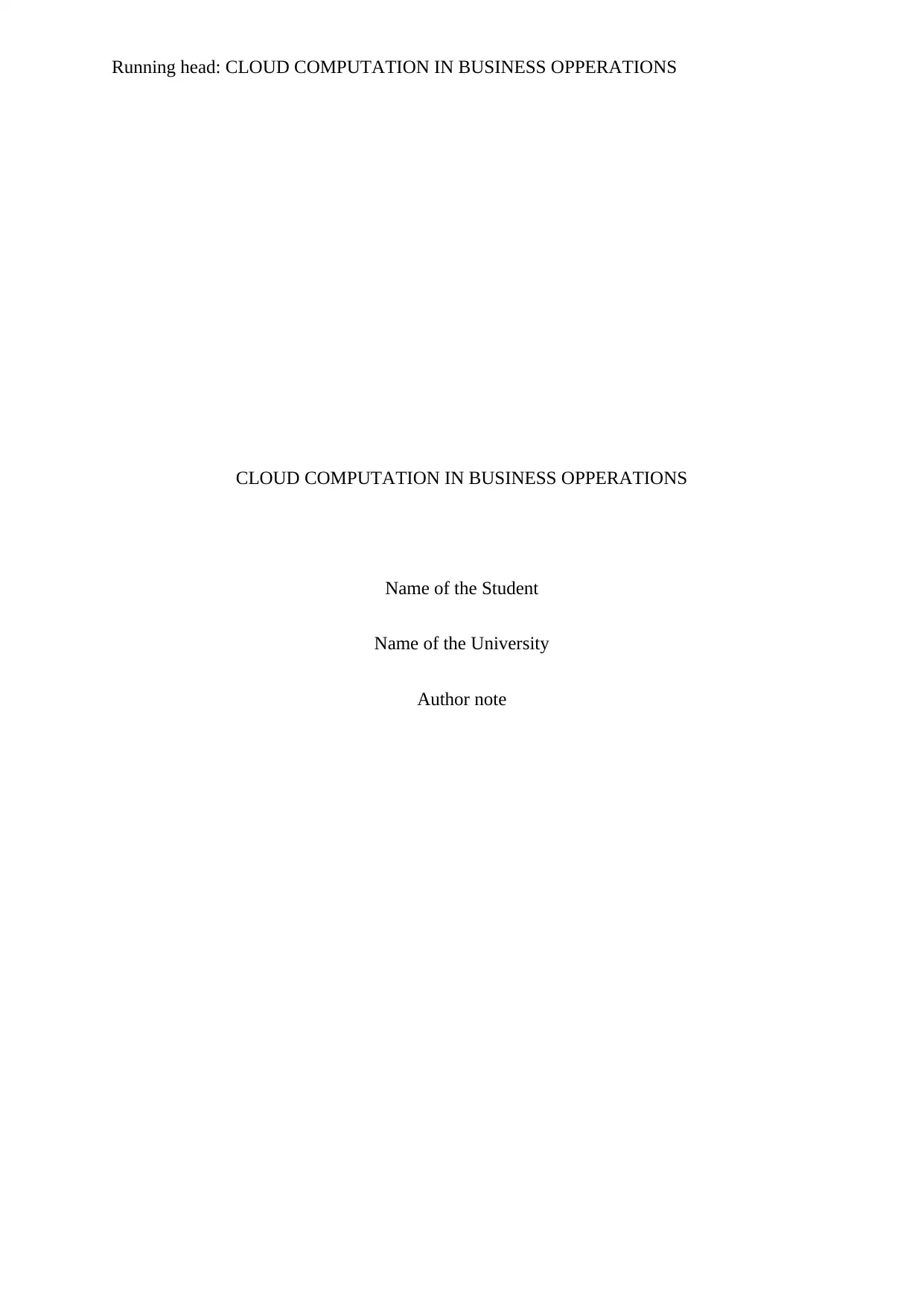
Running head: CLOUD COMPUTATION IN BUSINESS OPPERATIONS
CLOUD COMPUTATION IN BUSINESS OPPERATIONS
Name of the Student
Name of the University
Author note
CLOUD COMPUTATION IN BUSINESS OPPERATIONS
Name of the Student
Name of the University
Author note
Paraphrase This Document
Need a fresh take? Get an instant paraphrase of this document with our AI Paraphraser
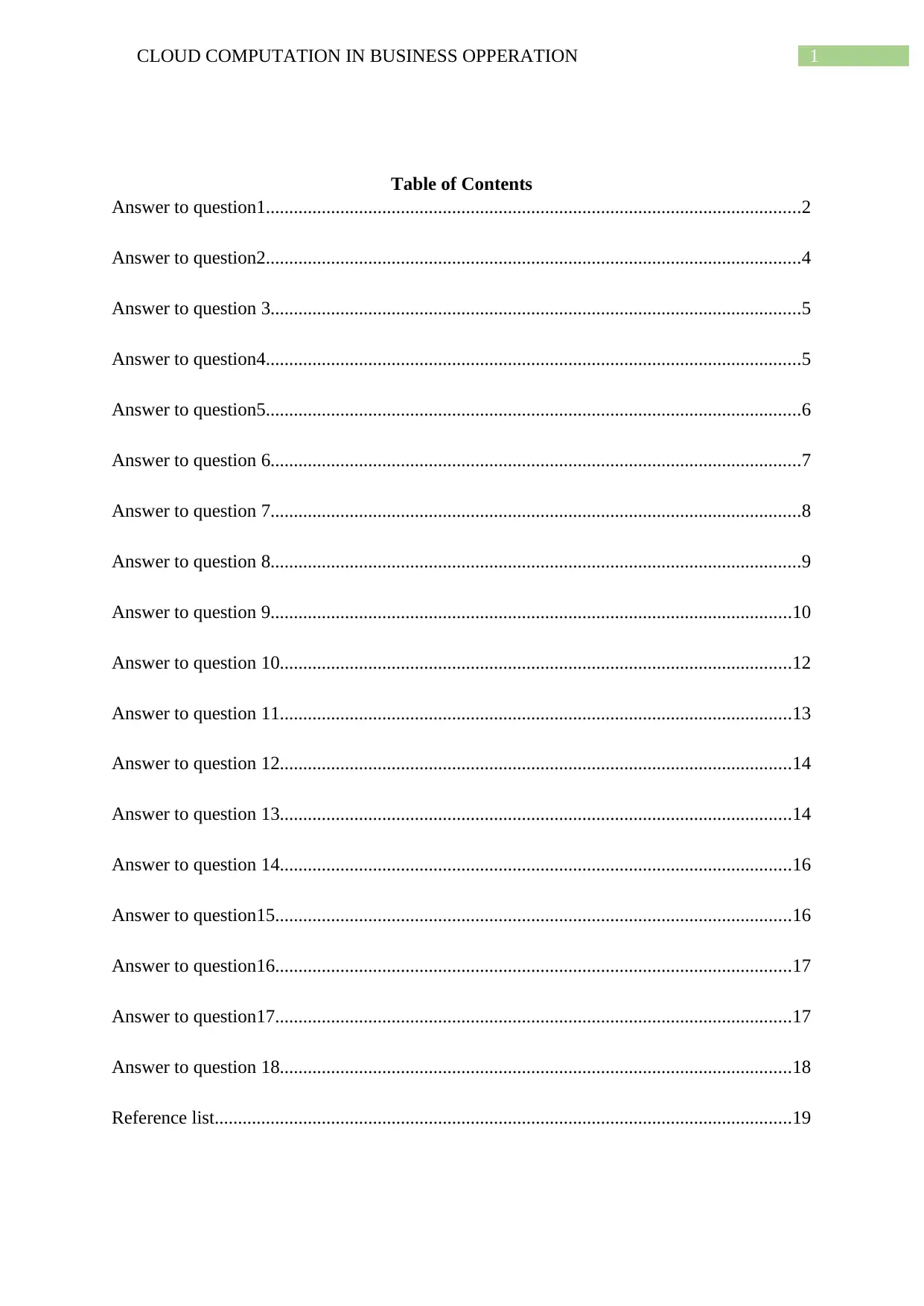
1CLOUD COMPUTATION IN BUSINESS OPPERATION
Table of Contents
Answer to question1...................................................................................................................2
Answer to question2...................................................................................................................4
Answer to question 3..................................................................................................................5
Answer to question4...................................................................................................................5
Answer to question5...................................................................................................................6
Answer to question 6..................................................................................................................7
Answer to question 7..................................................................................................................8
Answer to question 8..................................................................................................................9
Answer to question 9................................................................................................................10
Answer to question 10..............................................................................................................12
Answer to question 11..............................................................................................................13
Answer to question 12..............................................................................................................14
Answer to question 13..............................................................................................................14
Answer to question 14..............................................................................................................16
Answer to question15...............................................................................................................16
Answer to question16...............................................................................................................17
Answer to question17...............................................................................................................17
Answer to question 18..............................................................................................................18
Reference list............................................................................................................................19
Table of Contents
Answer to question1...................................................................................................................2
Answer to question2...................................................................................................................4
Answer to question 3..................................................................................................................5
Answer to question4...................................................................................................................5
Answer to question5...................................................................................................................6
Answer to question 6..................................................................................................................7
Answer to question 7..................................................................................................................8
Answer to question 8..................................................................................................................9
Answer to question 9................................................................................................................10
Answer to question 10..............................................................................................................12
Answer to question 11..............................................................................................................13
Answer to question 12..............................................................................................................14
Answer to question 13..............................................................................................................14
Answer to question 14..............................................................................................................16
Answer to question15...............................................................................................................16
Answer to question16...............................................................................................................17
Answer to question17...............................................................................................................17
Answer to question 18..............................................................................................................18
Reference list............................................................................................................................19
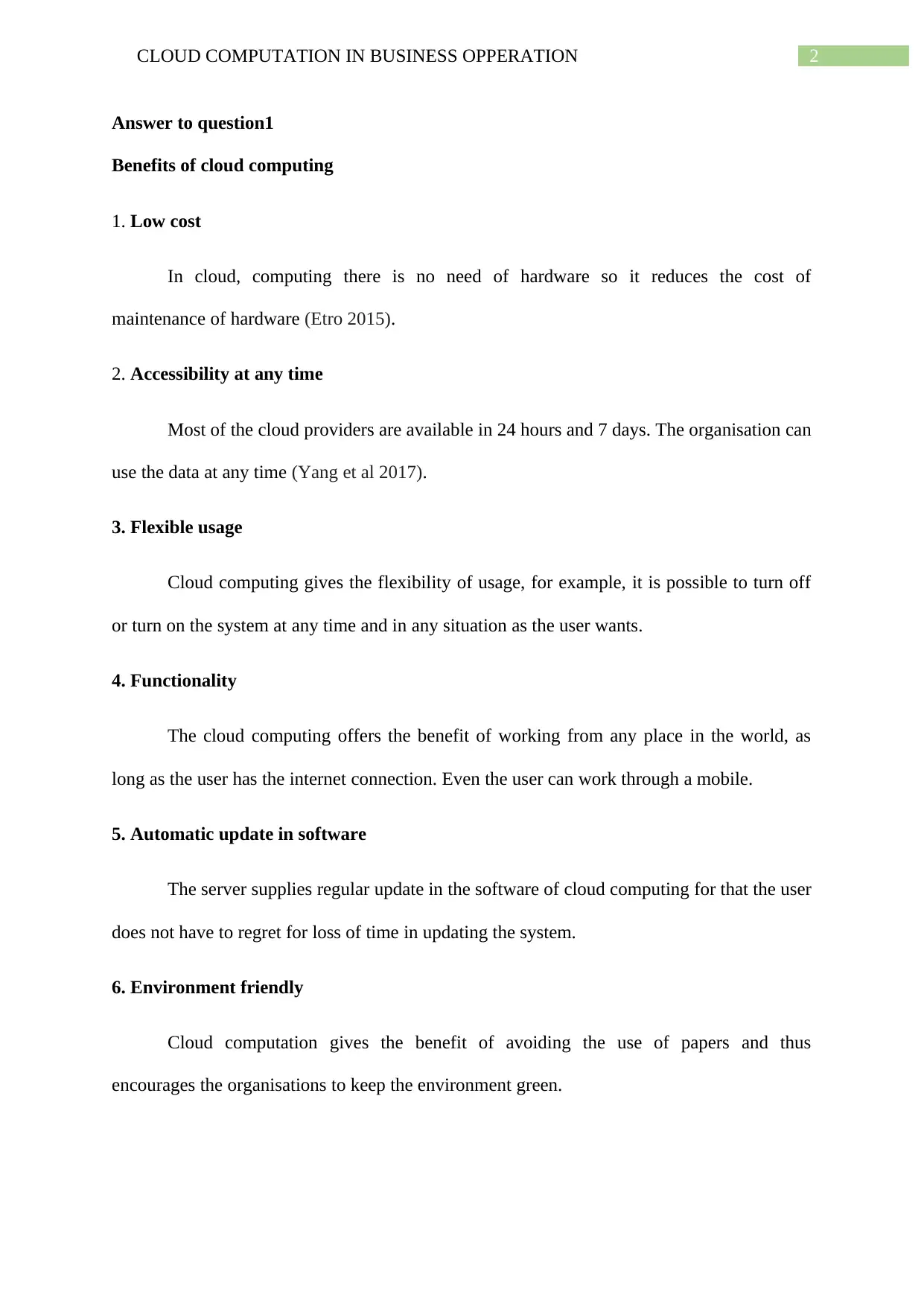
2CLOUD COMPUTATION IN BUSINESS OPPERATION
Answer to question1
Benefits of cloud computing
1. Low cost
In cloud, computing there is no need of hardware so it reduces the cost of
maintenance of hardware (Etro 2015).
2. Accessibility at any time
Most of the cloud providers are available in 24 hours and 7 days. The organisation can
use the data at any time (Yang et al 2017).
3. Flexible usage
Cloud computing gives the flexibility of usage, for example, it is possible to turn off
or turn on the system at any time and in any situation as the user wants.
4. Functionality
The cloud computing offers the benefit of working from any place in the world, as
long as the user has the internet connection. Even the user can work through a mobile.
5. Automatic update in software
The server supplies regular update in the software of cloud computing for that the user
does not have to regret for loss of time in updating the system.
6. Environment friendly
Cloud computation gives the benefit of avoiding the use of papers and thus
encourages the organisations to keep the environment green.
Answer to question1
Benefits of cloud computing
1. Low cost
In cloud, computing there is no need of hardware so it reduces the cost of
maintenance of hardware (Etro 2015).
2. Accessibility at any time
Most of the cloud providers are available in 24 hours and 7 days. The organisation can
use the data at any time (Yang et al 2017).
3. Flexible usage
Cloud computing gives the flexibility of usage, for example, it is possible to turn off
or turn on the system at any time and in any situation as the user wants.
4. Functionality
The cloud computing offers the benefit of working from any place in the world, as
long as the user has the internet connection. Even the user can work through a mobile.
5. Automatic update in software
The server supplies regular update in the software of cloud computing for that the user
does not have to regret for loss of time in updating the system.
6. Environment friendly
Cloud computation gives the benefit of avoiding the use of papers and thus
encourages the organisations to keep the environment green.
⊘ This is a preview!⊘
Do you want full access?
Subscribe today to unlock all pages.

Trusted by 1+ million students worldwide
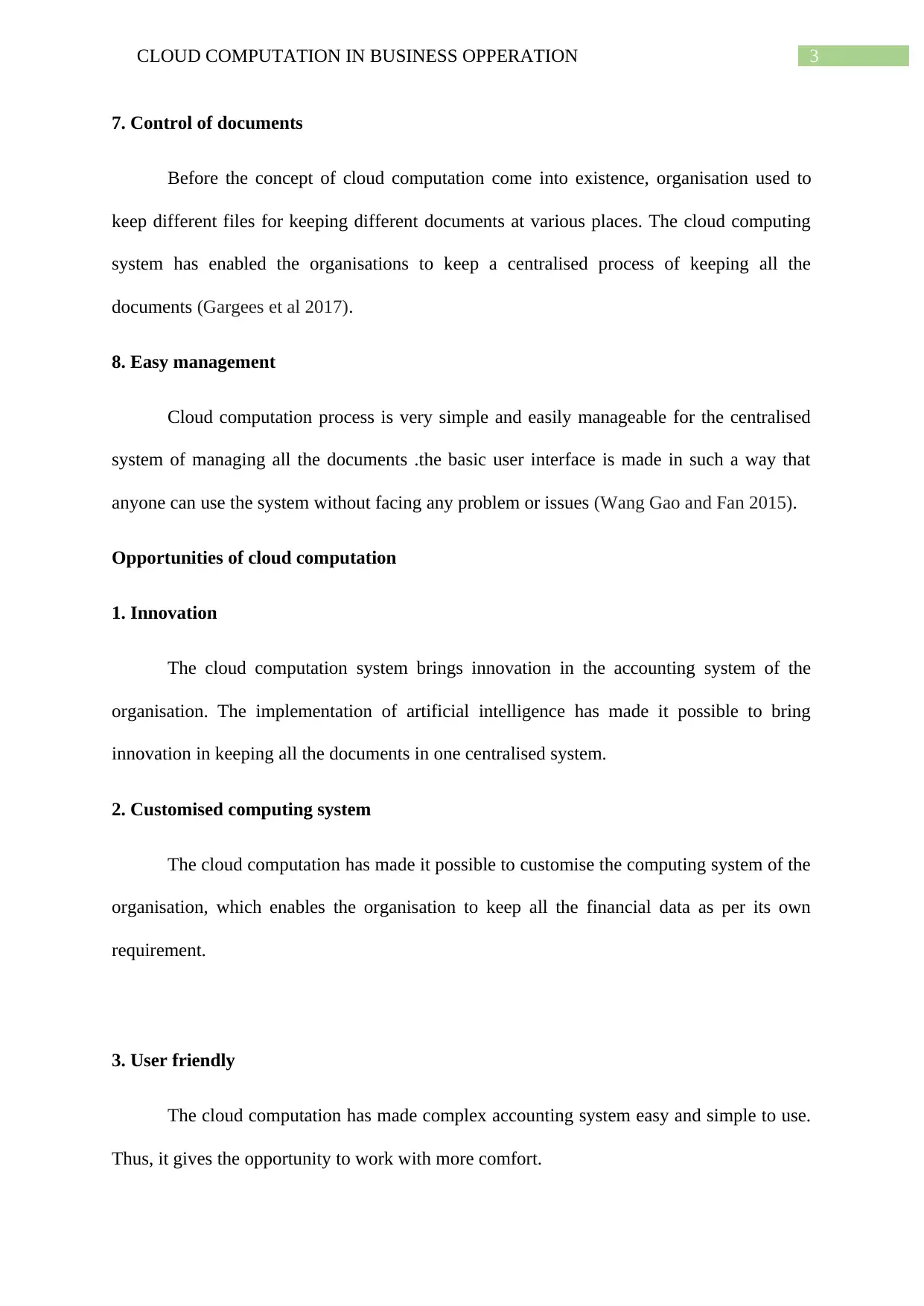
3CLOUD COMPUTATION IN BUSINESS OPPERATION
7. Control of documents
Before the concept of cloud computation come into existence, organisation used to
keep different files for keeping different documents at various places. The cloud computing
system has enabled the organisations to keep a centralised process of keeping all the
documents (Gargees et al 2017).
8. Easy management
Cloud computation process is very simple and easily manageable for the centralised
system of managing all the documents .the basic user interface is made in such a way that
anyone can use the system without facing any problem or issues (Wang Gao and Fan 2015).
Opportunities of cloud computation
1. Innovation
The cloud computation system brings innovation in the accounting system of the
organisation. The implementation of artificial intelligence has made it possible to bring
innovation in keeping all the documents in one centralised system.
2. Customised computing system
The cloud computation has made it possible to customise the computing system of the
organisation, which enables the organisation to keep all the financial data as per its own
requirement.
3. User friendly
The cloud computation has made complex accounting system easy and simple to use.
Thus, it gives the opportunity to work with more comfort.
7. Control of documents
Before the concept of cloud computation come into existence, organisation used to
keep different files for keeping different documents at various places. The cloud computing
system has enabled the organisations to keep a centralised process of keeping all the
documents (Gargees et al 2017).
8. Easy management
Cloud computation process is very simple and easily manageable for the centralised
system of managing all the documents .the basic user interface is made in such a way that
anyone can use the system without facing any problem or issues (Wang Gao and Fan 2015).
Opportunities of cloud computation
1. Innovation
The cloud computation system brings innovation in the accounting system of the
organisation. The implementation of artificial intelligence has made it possible to bring
innovation in keeping all the documents in one centralised system.
2. Customised computing system
The cloud computation has made it possible to customise the computing system of the
organisation, which enables the organisation to keep all the financial data as per its own
requirement.
3. User friendly
The cloud computation has made complex accounting system easy and simple to use.
Thus, it gives the opportunity to work with more comfort.
Paraphrase This Document
Need a fresh take? Get an instant paraphrase of this document with our AI Paraphraser
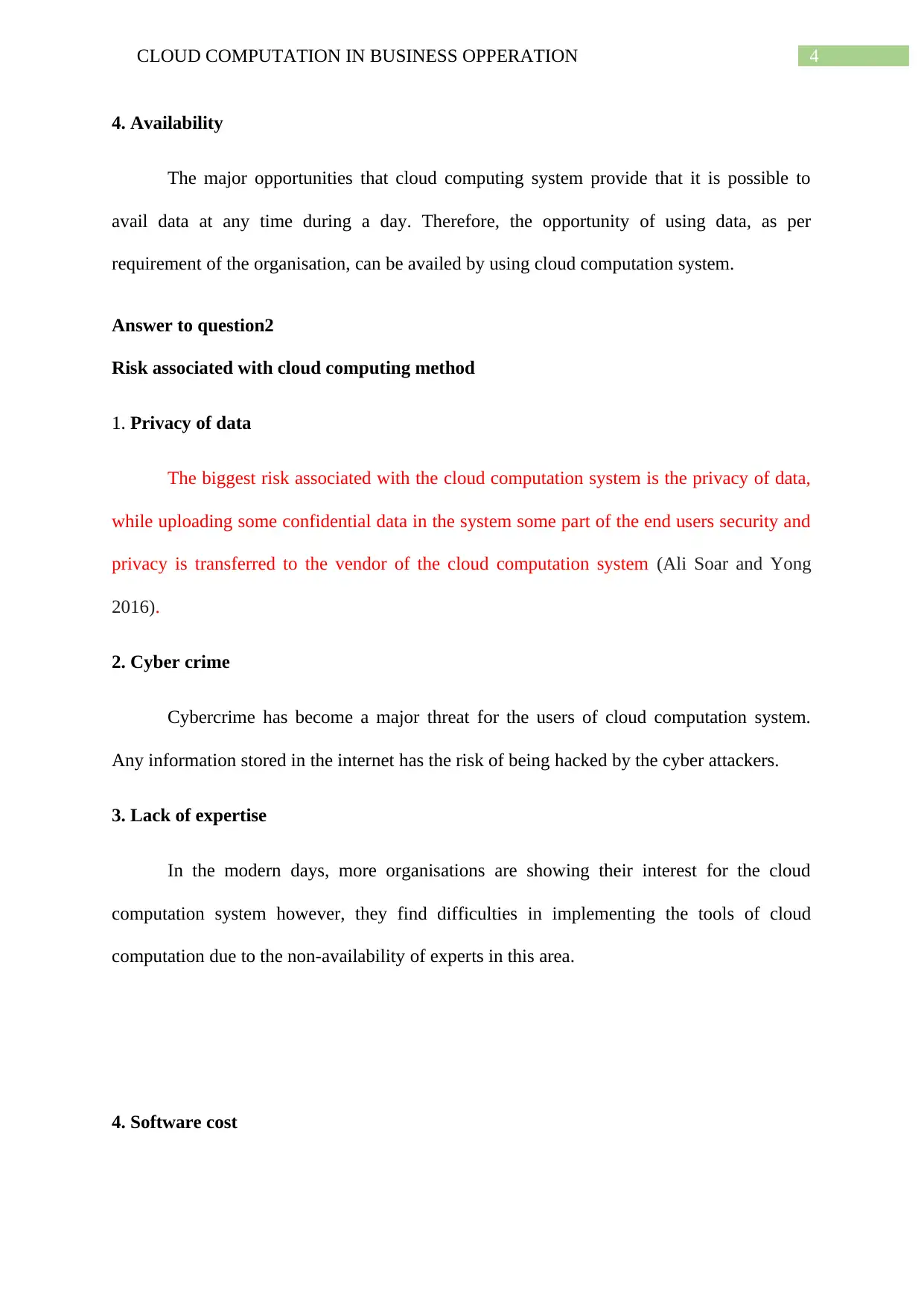
4CLOUD COMPUTATION IN BUSINESS OPPERATION
4. Availability
The major opportunities that cloud computing system provide that it is possible to
avail data at any time during a day. Therefore, the opportunity of using data, as per
requirement of the organisation, can be availed by using cloud computation system.
Answer to question2
Risk associated with cloud computing method
1. Privacy of data
The biggest risk associated with the cloud computation system is the privacy of data,
while uploading some confidential data in the system some part of the end users security and
privacy is transferred to the vendor of the cloud computation system (Ali Soar and Yong
2016).
2. Cyber crime
Cybercrime has become a major threat for the users of cloud computation system.
Any information stored in the internet has the risk of being hacked by the cyber attackers.
3. Lack of expertise
In the modern days, more organisations are showing their interest for the cloud
computation system however, they find difficulties in implementing the tools of cloud
computation due to the non-availability of experts in this area.
4. Software cost
4. Availability
The major opportunities that cloud computing system provide that it is possible to
avail data at any time during a day. Therefore, the opportunity of using data, as per
requirement of the organisation, can be availed by using cloud computation system.
Answer to question2
Risk associated with cloud computing method
1. Privacy of data
The biggest risk associated with the cloud computation system is the privacy of data,
while uploading some confidential data in the system some part of the end users security and
privacy is transferred to the vendor of the cloud computation system (Ali Soar and Yong
2016).
2. Cyber crime
Cybercrime has become a major threat for the users of cloud computation system.
Any information stored in the internet has the risk of being hacked by the cyber attackers.
3. Lack of expertise
In the modern days, more organisations are showing their interest for the cloud
computation system however, they find difficulties in implementing the tools of cloud
computation due to the non-availability of experts in this area.
4. Software cost
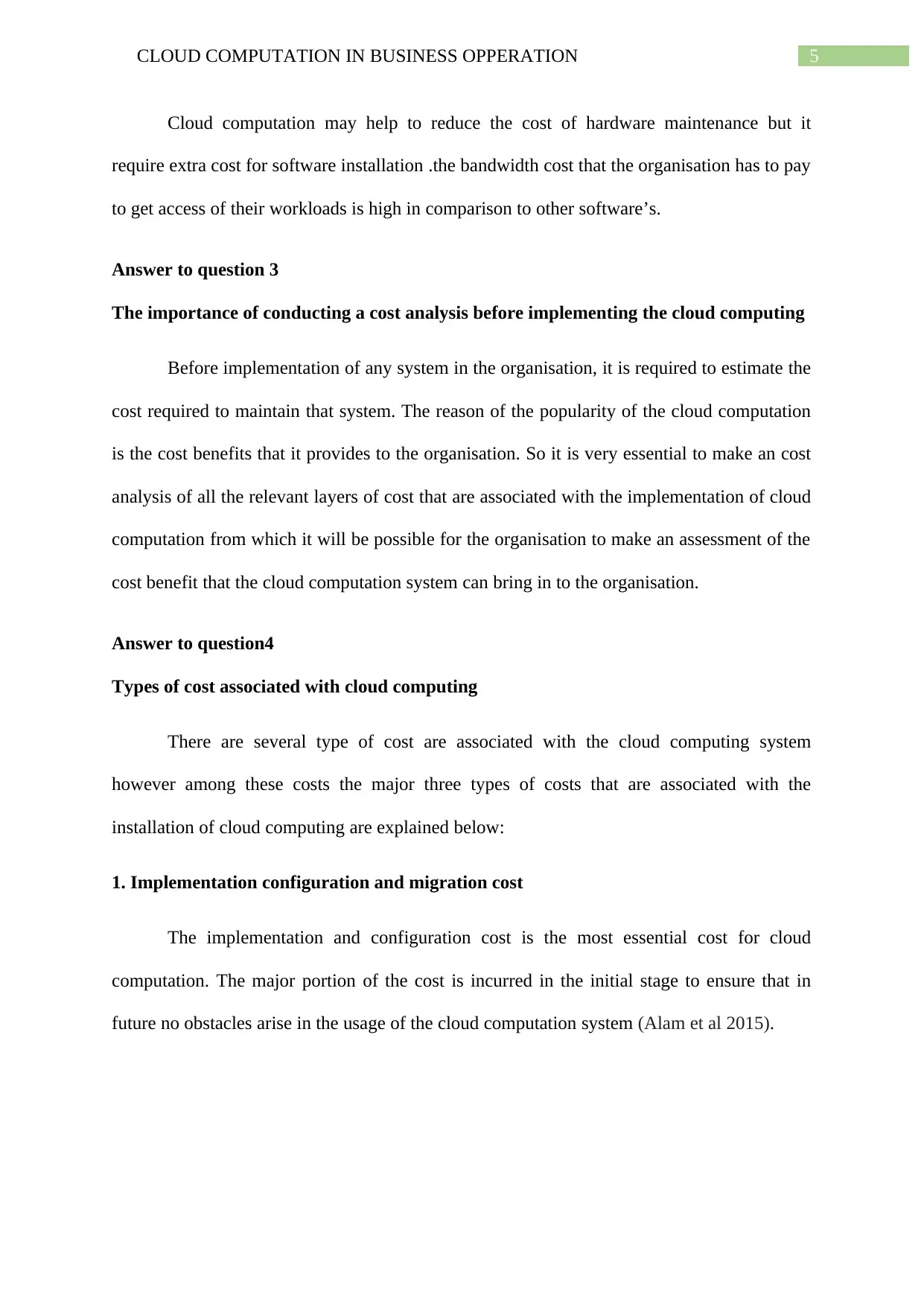
5CLOUD COMPUTATION IN BUSINESS OPPERATION
Cloud computation may help to reduce the cost of hardware maintenance but it
require extra cost for software installation .the bandwidth cost that the organisation has to pay
to get access of their workloads is high in comparison to other software’s.
Answer to question 3
The importance of conducting a cost analysis before implementing the cloud computing
Before implementation of any system in the organisation, it is required to estimate the
cost required to maintain that system. The reason of the popularity of the cloud computation
is the cost benefits that it provides to the organisation. So it is very essential to make an cost
analysis of all the relevant layers of cost that are associated with the implementation of cloud
computation from which it will be possible for the organisation to make an assessment of the
cost benefit that the cloud computation system can bring in to the organisation.
Answer to question4
Types of cost associated with cloud computing
There are several type of cost are associated with the cloud computing system
however among these costs the major three types of costs that are associated with the
installation of cloud computing are explained below:
1. Implementation configuration and migration cost
The implementation and configuration cost is the most essential cost for cloud
computation. The major portion of the cost is incurred in the initial stage to ensure that in
future no obstacles arise in the usage of the cloud computation system (Alam et al 2015).
Cloud computation may help to reduce the cost of hardware maintenance but it
require extra cost for software installation .the bandwidth cost that the organisation has to pay
to get access of their workloads is high in comparison to other software’s.
Answer to question 3
The importance of conducting a cost analysis before implementing the cloud computing
Before implementation of any system in the organisation, it is required to estimate the
cost required to maintain that system. The reason of the popularity of the cloud computation
is the cost benefits that it provides to the organisation. So it is very essential to make an cost
analysis of all the relevant layers of cost that are associated with the implementation of cloud
computation from which it will be possible for the organisation to make an assessment of the
cost benefit that the cloud computation system can bring in to the organisation.
Answer to question4
Types of cost associated with cloud computing
There are several type of cost are associated with the cloud computing system
however among these costs the major three types of costs that are associated with the
installation of cloud computing are explained below:
1. Implementation configuration and migration cost
The implementation and configuration cost is the most essential cost for cloud
computation. The major portion of the cost is incurred in the initial stage to ensure that in
future no obstacles arise in the usage of the cloud computation system (Alam et al 2015).
⊘ This is a preview!⊘
Do you want full access?
Subscribe today to unlock all pages.

Trusted by 1+ million students worldwide
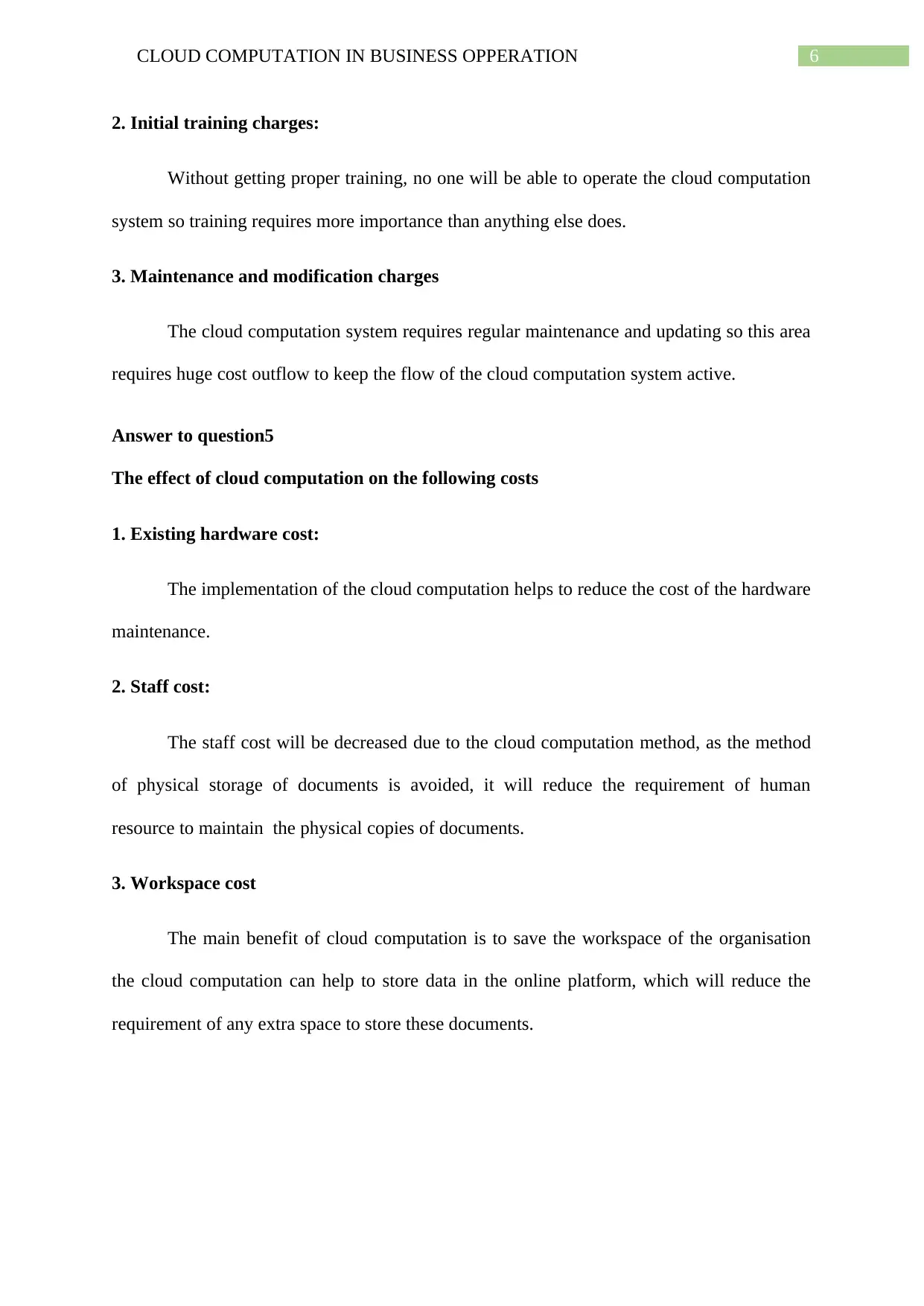
6CLOUD COMPUTATION IN BUSINESS OPPERATION
2. Initial training charges:
Without getting proper training, no one will be able to operate the cloud computation
system so training requires more importance than anything else does.
3. Maintenance and modification charges
The cloud computation system requires regular maintenance and updating so this area
requires huge cost outflow to keep the flow of the cloud computation system active.
Answer to question5
The effect of cloud computation on the following costs
1. Existing hardware cost:
The implementation of the cloud computation helps to reduce the cost of the hardware
maintenance.
2. Staff cost:
The staff cost will be decreased due to the cloud computation method, as the method
of physical storage of documents is avoided, it will reduce the requirement of human
resource to maintain the physical copies of documents.
3. Workspace cost
The main benefit of cloud computation is to save the workspace of the organisation
the cloud computation can help to store data in the online platform, which will reduce the
requirement of any extra space to store these documents.
2. Initial training charges:
Without getting proper training, no one will be able to operate the cloud computation
system so training requires more importance than anything else does.
3. Maintenance and modification charges
The cloud computation system requires regular maintenance and updating so this area
requires huge cost outflow to keep the flow of the cloud computation system active.
Answer to question5
The effect of cloud computation on the following costs
1. Existing hardware cost:
The implementation of the cloud computation helps to reduce the cost of the hardware
maintenance.
2. Staff cost:
The staff cost will be decreased due to the cloud computation method, as the method
of physical storage of documents is avoided, it will reduce the requirement of human
resource to maintain the physical copies of documents.
3. Workspace cost
The main benefit of cloud computation is to save the workspace of the organisation
the cloud computation can help to store data in the online platform, which will reduce the
requirement of any extra space to store these documents.
Paraphrase This Document
Need a fresh take? Get an instant paraphrase of this document with our AI Paraphraser
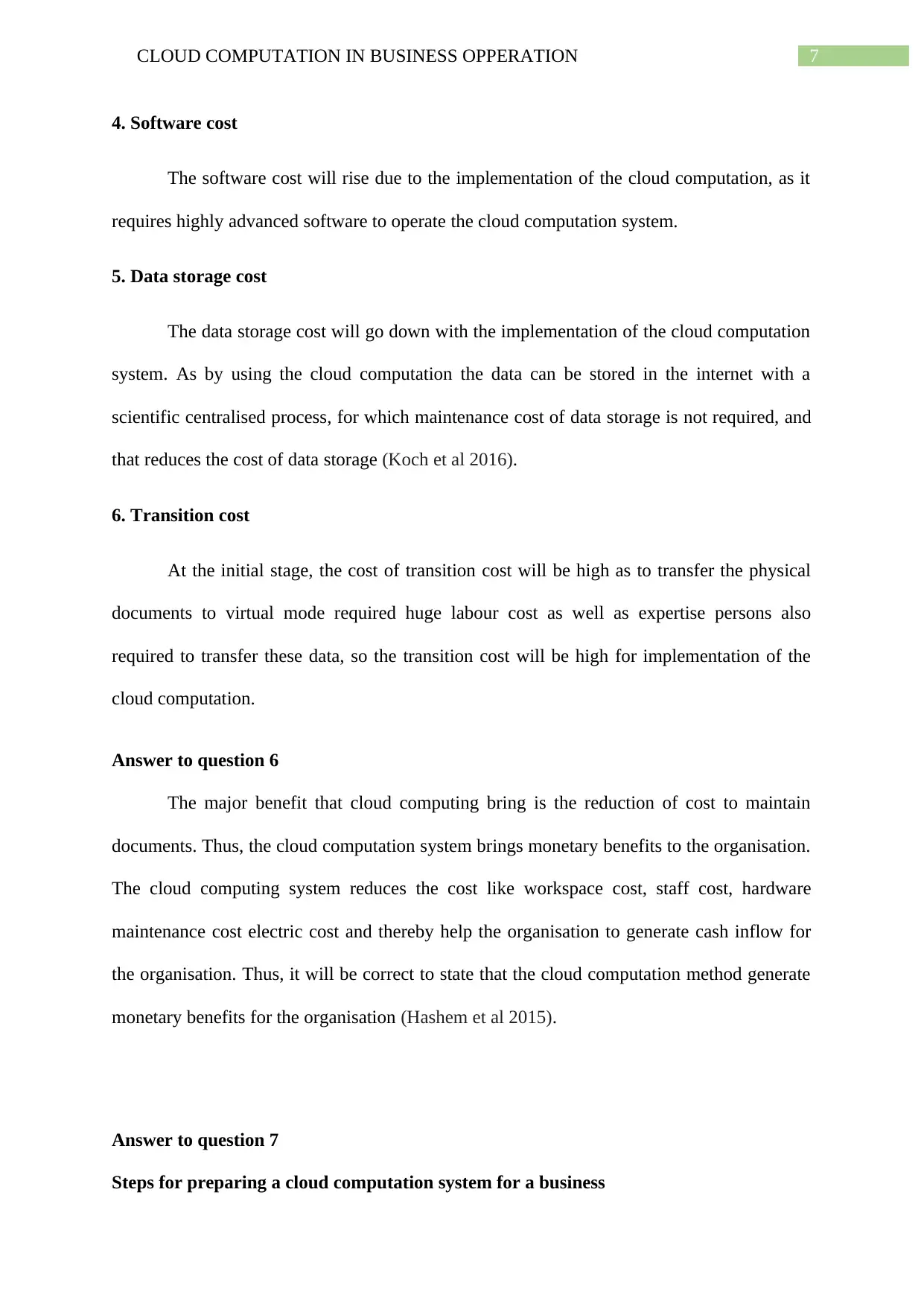
7CLOUD COMPUTATION IN BUSINESS OPPERATION
4. Software cost
The software cost will rise due to the implementation of the cloud computation, as it
requires highly advanced software to operate the cloud computation system.
5. Data storage cost
The data storage cost will go down with the implementation of the cloud computation
system. As by using the cloud computation the data can be stored in the internet with a
scientific centralised process, for which maintenance cost of data storage is not required, and
that reduces the cost of data storage (Koch et al 2016).
6. Transition cost
At the initial stage, the cost of transition cost will be high as to transfer the physical
documents to virtual mode required huge labour cost as well as expertise persons also
required to transfer these data, so the transition cost will be high for implementation of the
cloud computation.
Answer to question 6
The major benefit that cloud computing bring is the reduction of cost to maintain
documents. Thus, the cloud computation system brings monetary benefits to the organisation.
The cloud computing system reduces the cost like workspace cost, staff cost, hardware
maintenance cost electric cost and thereby help the organisation to generate cash inflow for
the organisation. Thus, it will be correct to state that the cloud computation method generate
monetary benefits for the organisation (Hashem et al 2015).
Answer to question 7
Steps for preparing a cloud computation system for a business
4. Software cost
The software cost will rise due to the implementation of the cloud computation, as it
requires highly advanced software to operate the cloud computation system.
5. Data storage cost
The data storage cost will go down with the implementation of the cloud computation
system. As by using the cloud computation the data can be stored in the internet with a
scientific centralised process, for which maintenance cost of data storage is not required, and
that reduces the cost of data storage (Koch et al 2016).
6. Transition cost
At the initial stage, the cost of transition cost will be high as to transfer the physical
documents to virtual mode required huge labour cost as well as expertise persons also
required to transfer these data, so the transition cost will be high for implementation of the
cloud computation.
Answer to question 6
The major benefit that cloud computing bring is the reduction of cost to maintain
documents. Thus, the cloud computation system brings monetary benefits to the organisation.
The cloud computing system reduces the cost like workspace cost, staff cost, hardware
maintenance cost electric cost and thereby help the organisation to generate cash inflow for
the organisation. Thus, it will be correct to state that the cloud computation method generate
monetary benefits for the organisation (Hashem et al 2015).
Answer to question 7
Steps for preparing a cloud computation system for a business
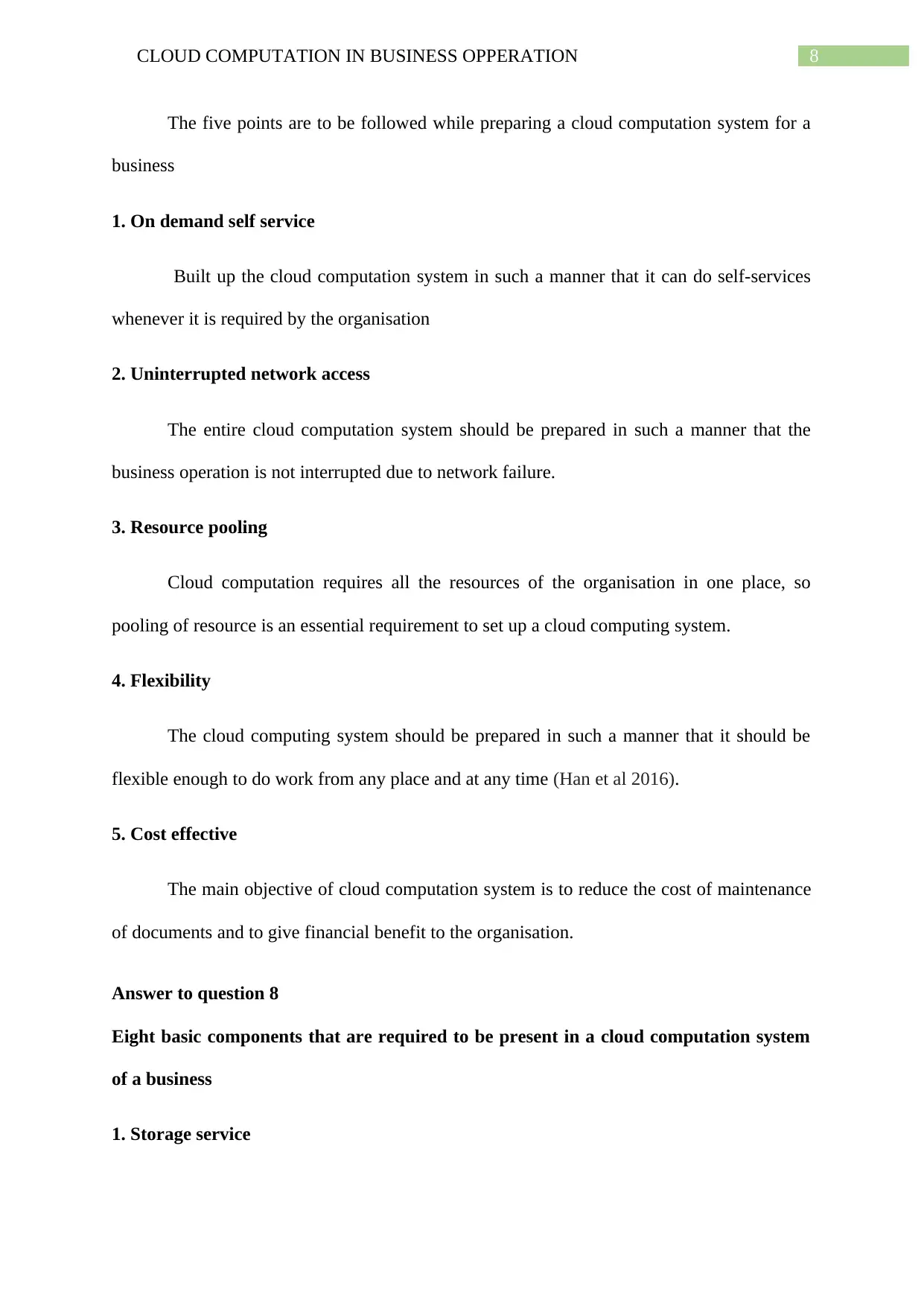
8CLOUD COMPUTATION IN BUSINESS OPPERATION
The five points are to be followed while preparing a cloud computation system for a
business
1. On demand self service
Built up the cloud computation system in such a manner that it can do self-services
whenever it is required by the organisation
2. Uninterrupted network access
The entire cloud computation system should be prepared in such a manner that the
business operation is not interrupted due to network failure.
3. Resource pooling
Cloud computation requires all the resources of the organisation in one place, so
pooling of resource is an essential requirement to set up a cloud computing system.
4. Flexibility
The cloud computing system should be prepared in such a manner that it should be
flexible enough to do work from any place and at any time (Han et al 2016).
5. Cost effective
The main objective of cloud computation system is to reduce the cost of maintenance
of documents and to give financial benefit to the organisation.
Answer to question 8
Eight basic components that are required to be present in a cloud computation system
of a business
1. Storage service
The five points are to be followed while preparing a cloud computation system for a
business
1. On demand self service
Built up the cloud computation system in such a manner that it can do self-services
whenever it is required by the organisation
2. Uninterrupted network access
The entire cloud computation system should be prepared in such a manner that the
business operation is not interrupted due to network failure.
3. Resource pooling
Cloud computation requires all the resources of the organisation in one place, so
pooling of resource is an essential requirement to set up a cloud computing system.
4. Flexibility
The cloud computing system should be prepared in such a manner that it should be
flexible enough to do work from any place and at any time (Han et al 2016).
5. Cost effective
The main objective of cloud computation system is to reduce the cost of maintenance
of documents and to give financial benefit to the organisation.
Answer to question 8
Eight basic components that are required to be present in a cloud computation system
of a business
1. Storage service
⊘ This is a preview!⊘
Do you want full access?
Subscribe today to unlock all pages.

Trusted by 1+ million students worldwide
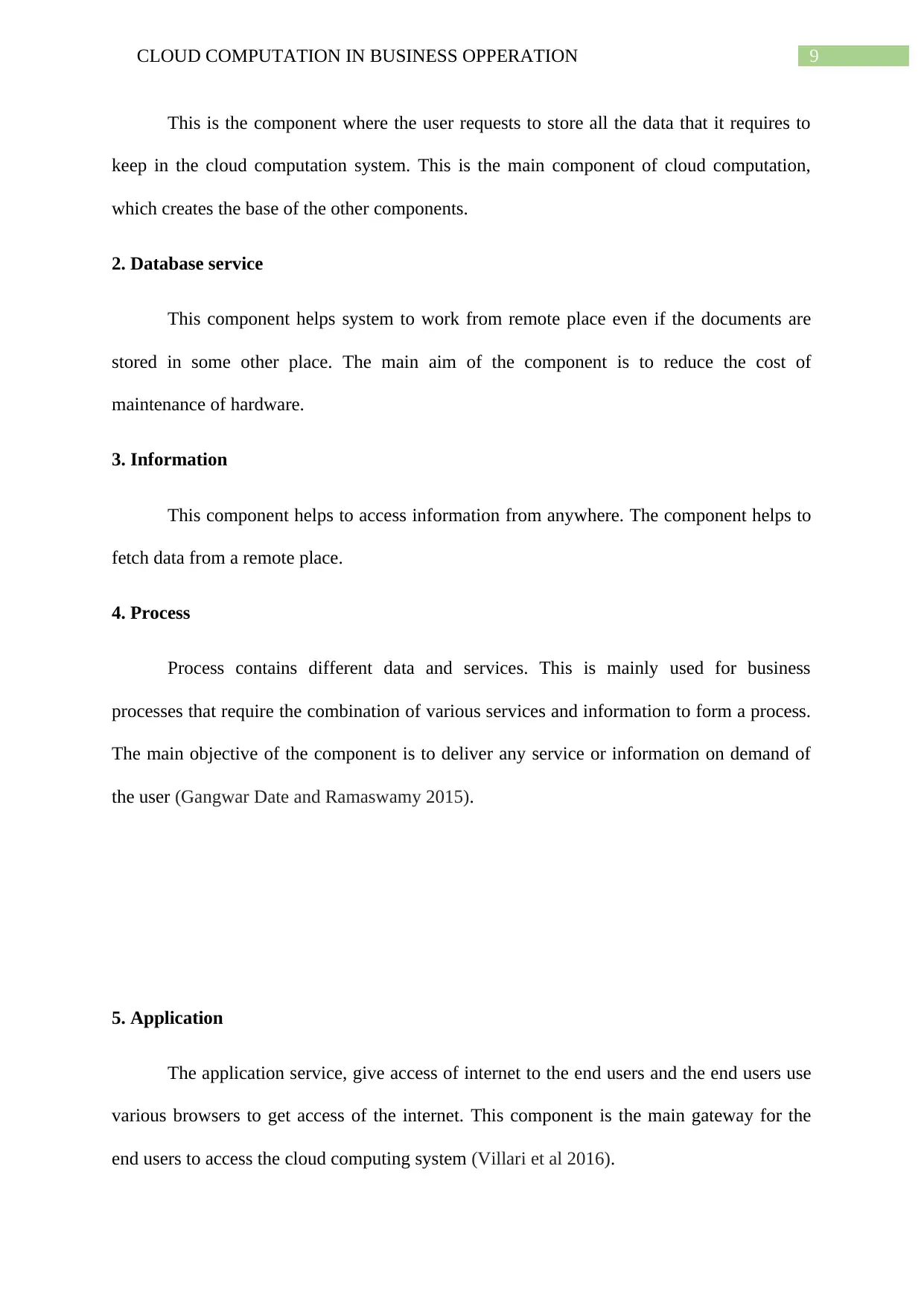
9CLOUD COMPUTATION IN BUSINESS OPPERATION
This is the component where the user requests to store all the data that it requires to
keep in the cloud computation system. This is the main component of cloud computation,
which creates the base of the other components.
2. Database service
This component helps system to work from remote place even if the documents are
stored in some other place. The main aim of the component is to reduce the cost of
maintenance of hardware.
3. Information
This component helps to access information from anywhere. The component helps to
fetch data from a remote place.
4. Process
Process contains different data and services. This is mainly used for business
processes that require the combination of various services and information to form a process.
The main objective of the component is to deliver any service or information on demand of
the user (Gangwar Date and Ramaswamy 2015).
5. Application
The application service, give access of internet to the end users and the end users use
various browsers to get access of the internet. This component is the main gateway for the
end users to access the cloud computing system (Villari et al 2016).
This is the component where the user requests to store all the data that it requires to
keep in the cloud computation system. This is the main component of cloud computation,
which creates the base of the other components.
2. Database service
This component helps system to work from remote place even if the documents are
stored in some other place. The main aim of the component is to reduce the cost of
maintenance of hardware.
3. Information
This component helps to access information from anywhere. The component helps to
fetch data from a remote place.
4. Process
Process contains different data and services. This is mainly used for business
processes that require the combination of various services and information to form a process.
The main objective of the component is to deliver any service or information on demand of
the user (Gangwar Date and Ramaswamy 2015).
5. Application
The application service, give access of internet to the end users and the end users use
various browsers to get access of the internet. This component is the main gateway for the
end users to access the cloud computing system (Villari et al 2016).
Paraphrase This Document
Need a fresh take? Get an instant paraphrase of this document with our AI Paraphraser
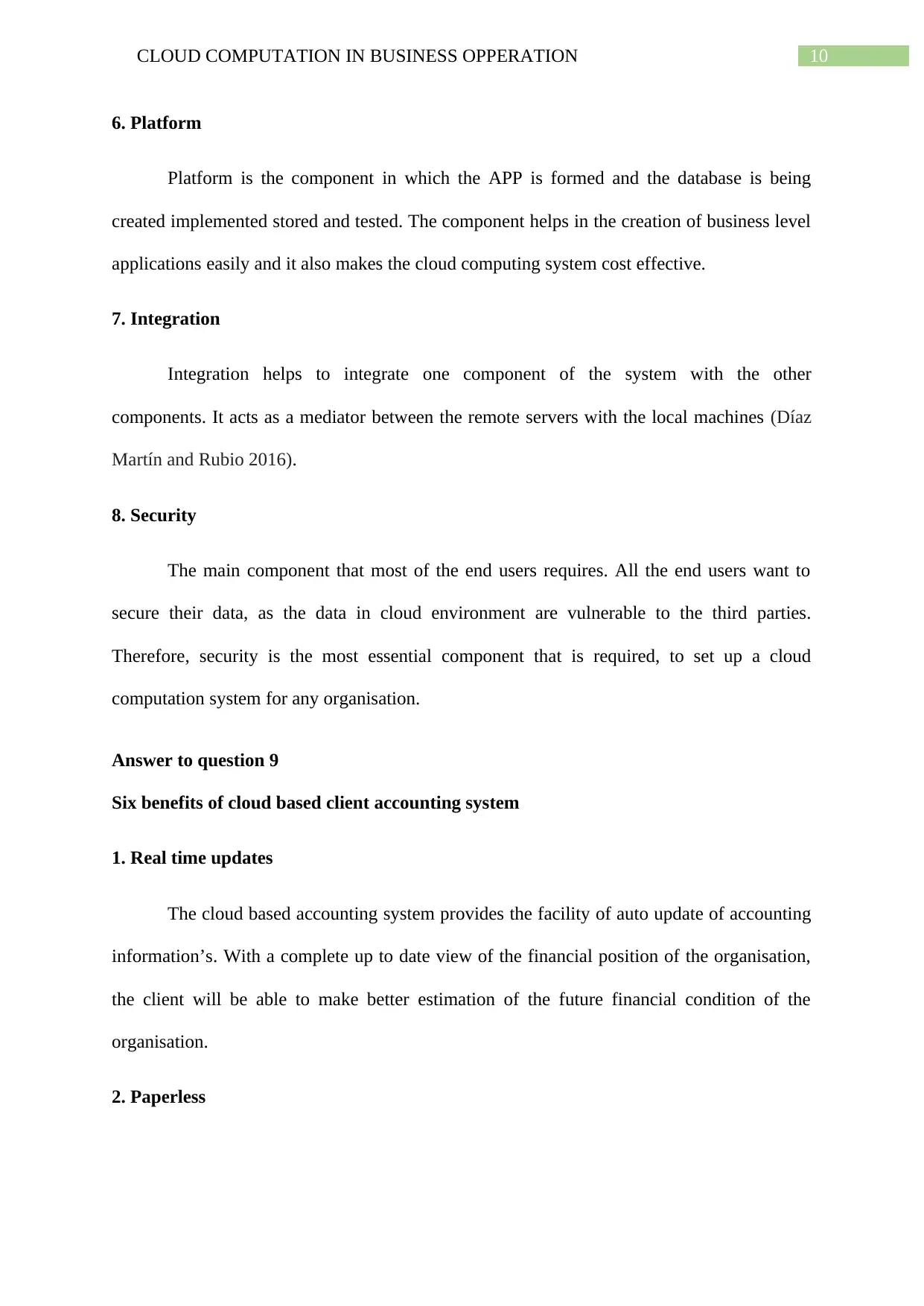
10CLOUD COMPUTATION IN BUSINESS OPPERATION
6. Platform
Platform is the component in which the APP is formed and the database is being
created implemented stored and tested. The component helps in the creation of business level
applications easily and it also makes the cloud computing system cost effective.
7. Integration
Integration helps to integrate one component of the system with the other
components. It acts as a mediator between the remote servers with the local machines (Díaz
Martín and Rubio 2016).
8. Security
The main component that most of the end users requires. All the end users want to
secure their data, as the data in cloud environment are vulnerable to the third parties.
Therefore, security is the most essential component that is required, to set up a cloud
computation system for any organisation.
Answer to question 9
Six benefits of cloud based client accounting system
1. Real time updates
The cloud based accounting system provides the facility of auto update of accounting
information’s. With a complete up to date view of the financial position of the organisation,
the client will be able to make better estimation of the future financial condition of the
organisation.
2. Paperless
6. Platform
Platform is the component in which the APP is formed and the database is being
created implemented stored and tested. The component helps in the creation of business level
applications easily and it also makes the cloud computing system cost effective.
7. Integration
Integration helps to integrate one component of the system with the other
components. It acts as a mediator between the remote servers with the local machines (Díaz
Martín and Rubio 2016).
8. Security
The main component that most of the end users requires. All the end users want to
secure their data, as the data in cloud environment are vulnerable to the third parties.
Therefore, security is the most essential component that is required, to set up a cloud
computation system for any organisation.
Answer to question 9
Six benefits of cloud based client accounting system
1. Real time updates
The cloud based accounting system provides the facility of auto update of accounting
information’s. With a complete up to date view of the financial position of the organisation,
the client will be able to make better estimation of the future financial condition of the
organisation.
2. Paperless
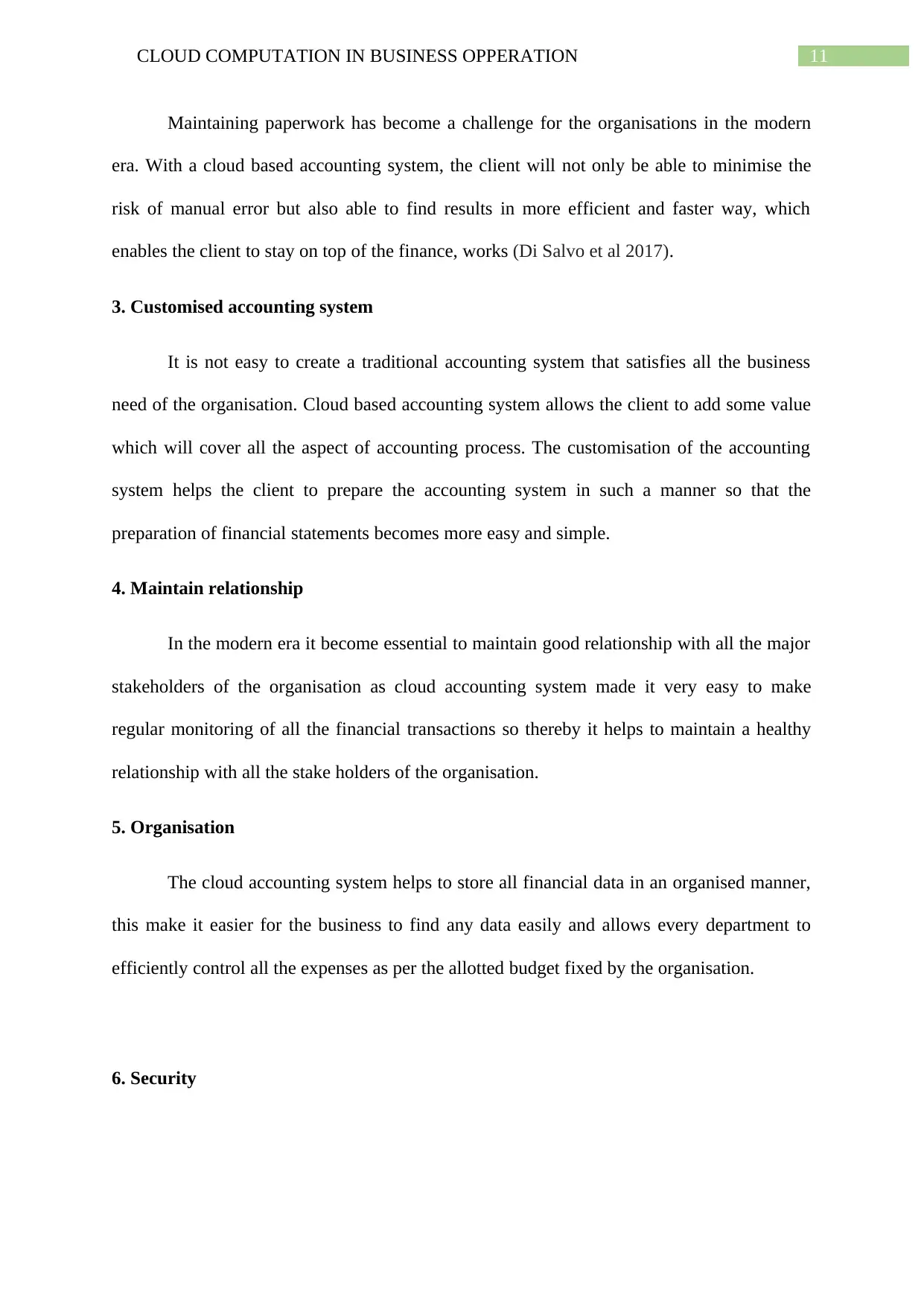
11CLOUD COMPUTATION IN BUSINESS OPPERATION
Maintaining paperwork has become a challenge for the organisations in the modern
era. With a cloud based accounting system, the client will not only be able to minimise the
risk of manual error but also able to find results in more efficient and faster way, which
enables the client to stay on top of the finance, works (Di Salvo et al 2017).
3. Customised accounting system
It is not easy to create a traditional accounting system that satisfies all the business
need of the organisation. Cloud based accounting system allows the client to add some value
which will cover all the aspect of accounting process. The customisation of the accounting
system helps the client to prepare the accounting system in such a manner so that the
preparation of financial statements becomes more easy and simple.
4. Maintain relationship
In the modern era it become essential to maintain good relationship with all the major
stakeholders of the organisation as cloud accounting system made it very easy to make
regular monitoring of all the financial transactions so thereby it helps to maintain a healthy
relationship with all the stake holders of the organisation.
5. Organisation
The cloud accounting system helps to store all financial data in an organised manner,
this make it easier for the business to find any data easily and allows every department to
efficiently control all the expenses as per the allotted budget fixed by the organisation.
6. Security
Maintaining paperwork has become a challenge for the organisations in the modern
era. With a cloud based accounting system, the client will not only be able to minimise the
risk of manual error but also able to find results in more efficient and faster way, which
enables the client to stay on top of the finance, works (Di Salvo et al 2017).
3. Customised accounting system
It is not easy to create a traditional accounting system that satisfies all the business
need of the organisation. Cloud based accounting system allows the client to add some value
which will cover all the aspect of accounting process. The customisation of the accounting
system helps the client to prepare the accounting system in such a manner so that the
preparation of financial statements becomes more easy and simple.
4. Maintain relationship
In the modern era it become essential to maintain good relationship with all the major
stakeholders of the organisation as cloud accounting system made it very easy to make
regular monitoring of all the financial transactions so thereby it helps to maintain a healthy
relationship with all the stake holders of the organisation.
5. Organisation
The cloud accounting system helps to store all financial data in an organised manner,
this make it easier for the business to find any data easily and allows every department to
efficiently control all the expenses as per the allotted budget fixed by the organisation.
6. Security
⊘ This is a preview!⊘
Do you want full access?
Subscribe today to unlock all pages.

Trusted by 1+ million students worldwide
1 out of 27
Related Documents
Your All-in-One AI-Powered Toolkit for Academic Success.
+13062052269
info@desklib.com
Available 24*7 on WhatsApp / Email
![[object Object]](/_next/static/media/star-bottom.7253800d.svg)
Unlock your academic potential
Copyright © 2020–2025 A2Z Services. All Rights Reserved. Developed and managed by ZUCOL.




